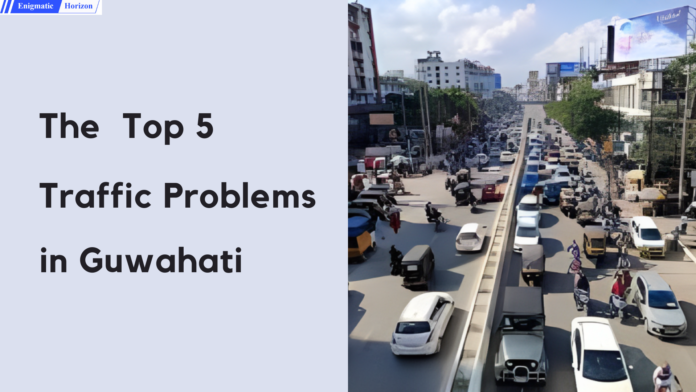Rinku Sharma
Guwahati, known as the “gateway to North East India,” is well-known for its vibrant culture, rich heritage, and vibrant festivals, but it also suffers from persistent traffic congestion. Guwahati’s traffic conditions have steadily deteriorated over the past few decades. According to a traffic survey report made public by the Assam Police, 98,581 vehicles were registered in Guwahati between April 2018 and March 2019. This accounts for nearly 20% of all vehicles registered in Assam. This has led to an alarming rise in excessive vehicles and increased road traffic issues in the city. In this article, we will discuss the top 5 biggest traffic problems in Guwahati that plague the city and affect everyone, including commuters in buses, cars, bikes, and other private vehicles.
1. No proper maintenance of lane discipline
Guwahati’s lack of lane discipline is one of the main causes of traffic jams. There are instances where vehicles attempt to overtake or change lanes without using proper lane discipline, which is likely to halt traffic. Lane discipline dictates that traffic should stay in the left (slow) lane and let fast-moving cars pass in the right (faster) lane; nevertheless, this is rarely observed on the roads in Guwahati. Drivers and motorcyclists are commonly spotted entering “No Entry” zones in the Fancy Bazar area, which results in jams. Drivers abruptly change lanes without using their turn signals. The Beltola Tiniali region has the weakest traffic control and much poorer lane discipline, as you will notice. In Paltan Bazar and Zoo Road, the same thing takes place. To better enforce lane discipline, traffic police must be deployed at regular intervals, and speed detectors and cameras must also be installed.
2. No implementation of stop signal/red light protocol
Traffic signals now govern a large majority of driveways in Guwahati. But the signal lights aren’t being used correctly. On Guwahati roads, poorly timed traffic signals contribute to more than just driver confusion. Poorly timed traffic signals are the result of a number of situations, such as equipment failure, a lack of traffic experts, and outdated traffic analyses. At intersections, crossroads, and zebra crossings, traffic lights are intended to facilitate smooth traffic flow. However, some Guwahati drivers are in such a rush that they hardly care to stop at stop signs. Additionally, you’ll see some vehicles failing to yield to pedestrians at the zebra crossing. On the highways of Guwahati, it’s not uncommon to see drivers taking U-turns in areas where doing so is expressly forbidden. Unbearable traffic is present on the Six-Mile stretch in Guwahati. The same is true at the Beltola Tiniali point, where traffic is frequently frustrating and the signals are useless.
3. Implementation of no pedestrian laws
Vehicle speeds and other significant safety hazards for pedestrians are not adequately addressed. Vehicle operators do not take the necessary precautions to prevent hitting pedestrians on a roadway. Even when required, they fail to blow the horn as a warning. Drivers rarely follow the speed limitations of that specific road, whether they are driving a car or riding a two-wheeler. Even at intersections, drivers rarely stop to let bicyclists and pedestrians cross the street, which causes severe traffic bottlenecks in the city.
4. The wrong violation not being checked
The state government frequently makes significant modifications to the fines for traffic violations, but these changes are not fully enforced. The relatively new traffic laws in Guwahati were stricter, with fines for disobeying traffic lights, driving or riding without a helmet, seat belt, or insurance, among other things. However, these were only upheld for a year before they were abandoned. Sometimes, one can see traffic police officers under the Ganeshguri flyover ticketing riders for not wearing helmets and the next time letting bikes pass unchecked. On the highway stretch at Basistha Chariali, similar scenes may be seen. The traffic control authorities also do not properly monitor violations of traffic laws, such as making a wrong U-Turn, speeding, etc.
5. Police officials are not aware of basic rules
Even more intriguing is the fact that traffic control personnel are less vigilant when it comes to enforcing even the most fundamental driving laws. Traffic rules like illegal parking, disobeying traffic laws, driving or riding without a valid driving licence, rash driving, operating a vehicle while intoxicated, failing to yield to emergency vehicles, etc. are basic rules that traffic control personnel often choose to ignore. The police force also seems to make minimal efforts to reduce traffic congestion in the worst traffic-hit areas of Maligaon, Ulubari, and G.S. Road.
To reduce traffic congestion in Guwahati, it is important to maintain lane discipline, improve the condition of the roads, and execute traffic signal laws. However, fewer vehicles on the road and well-maintained pathways and footpaths would also help manage traffic in the city to a great extent.
